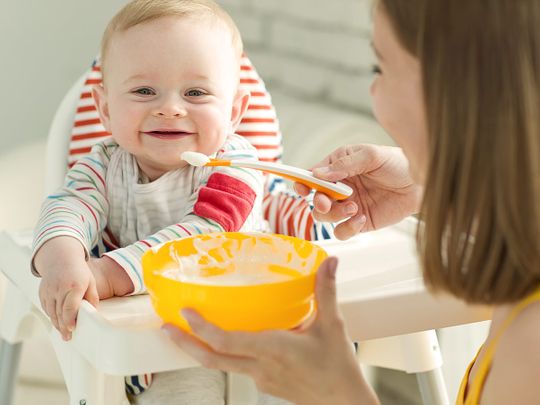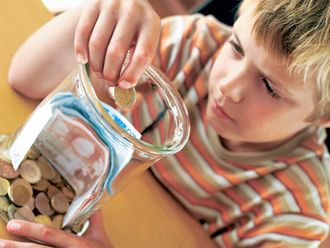
There are few things more exciting than watching your baby taste food for the first time. Not only is it a huge milestone in their development and the start of a lifetime relationship with food, but it is always worthy of a photo or two for the facial expressions alone!
As parents, however, knowing when to start weaning (and how exactly we should be doing it) can be daunting. So we’ve approached two Dubai-based experts for advice; Dru Campbell, head midwife at Healthbay Polyclinic and Amy Vogelaar, antenatal and parenting educator at Love Parenting UAE.
So what exactly is weaning? “Weaning is moving from complete milk feeds to combining milk feeds with solid foods”, explains Dru Campbell. “It’s the idea of offering solid foods to babies is to get them used to experiencing different tastes and textures of various food types.”
Amy Vogelaar adds, “The recommended age to start weaning has varied significantly over the years and in different cultures, but it has recently been recommended that we start between four to six months of age. However, most health authorities such as the World Health Organization, American Academy of Pediatrics and National Health Service recommend waiting until six months. This is in the belief that breastmilk meets most babies’ needs completely until that age, babies’ digestive and immune systems may not be ready for anything else before that age, and in the hopes that more mothers will exclusively breastfeed for the full six months – which brings a multitude of benefits.“
It’s also very important that you continue to feed your baby milk after beginning weaning. Dru Campbell explains: “Milk feeds are crucial to a baby’s nutrition and development until they are twelve months of age. Therefore, the milk feeds (whether it be breast or formula milk) are the most important. Solid foods are only to get babies used to different tastes and textures, rather than providing complete nutrition.“
TRADITIONAL PURÉE WEANING
By Dru Campbell, head midwife and lactation consultant at Healthbay Polyclinic
What is it?
Purée feeding is steaming and cooking food – and then puréeing it so that it is more liquid than solid. It’s the more traditional way to commence solids.
How to start?
Once your baby is commencing solids – from six months of age – you can start introducing various types of food.
It’s a good idea to start with one meal per day (some time after a milk feed) and then this can be increased over time, so that your baby is eventually eating three solid meals per day. I recommend starting with one particular food for two days or so, so that if your baby has a reaction to a type of food, you know what has caused it. Be as relaxed as you can about introducing solid food – it should be fun and enjoyable!
Best first tastes?
Traditionally, baby rice or baby porridge are given – but I would check the ingredients of the baby rice or porridge carefully to ensure there is no sugar added. Babies do not need any sugar or salt added to their food. Vegetables and fruits are extremely healthy and palatable solid foods to commence with – babies love sweet vegetables such as butternut squash and carrots.
How do I make the purées?
Steaming fruits and vegetables is a wonderful way of keeping the nutrient content within the food. Puréeing foods can be done by use of a hand or electric blender. If you wish to make foods in batches, you can put foods into smaller containers to provide to your baby at a later date. The amount of food given will depend on what your baby wants. Room temperature (slightly warmed) is the best temperature to provide your baby food – and you must always test food before you give it to your baby to ensure it is not too hot. You can also freeze the purées in portions to save yourself time. Most vegetable and fruit solids can be frozen for up to one month to save time. You can either defrost the food in the refrigerator overnight or place the container in warm water to thaw.
When should I move to lumpier food and finger foods?
Lumpier foods can be given when your baby is ready, but definitely by eight months of age. Finger foods can be given when your baby is able to pick the food up in his or her hand.

Safety advice?
Safety is very important when you are commencing on solid foods. Ensure your baby is always safely sitting upright and ensure he or she is supervised at all times.
Where can I get more information?
Drop into the Healthbay Polyclinic Baby Clinic and chat to any of the midwives (04 348 7140) or visit www.annabelkarmel.com or www.kellymom.com.
BABY-LED WEANING
By Amy Vogelaar, lactation consultant and antenatal and parenting educator at Love Parenting UAE (www.loveparentinguae.com)
What is it?
Baby-led weaning is a method of introducing solids to a six-month or older baby without purées or spoon-feeding. You offer solid foods, in chip-shaped forms, so your baby can grasp it in his or her fist and chew on the bit that sticks out. Your baby decides what to eat, how much to eat, and whether to eat at all. This follows the same principles as on-demand breastfeeding – babies instinctively know when they are hungry and when they are full.
How to start?
Between six and 12 months offer milk feeds first and solids later. This way, your baby doesn’t miss out on the breastmilk or formula she still needs – and she is isn’t starving and frustrated when it is time to experiment with food. About 30-60 minutes after milk seems to work for most. Many families start with one solid food meal or snack a day and then gradually build up from there as baby shows interest. Others will jump right in and offer a little something to baby every time they sit down to a meal or a snack. Fortunately there is no one right way, so whatever suits you and your baby is fine.
Best first tastes?
One of the best things about Baby-led weaning is that it comes with very few hard and fast rules. You can get started by offering pieces of solid food in chip-shaped or finger-shaped slices or chunks. Some popular first foods include vegetables and fruits such as cucumber sticks, avocado slices, banana slices, steamed carrot sticks, steamed apple slices, steamed broccoli florets, and the like (messy but fun). It is also important to offer iron-rich foods, so strips of meat, poultry or fish, chicken drumsticks, lamb chops, and more should also be among the early foods offered (along with vitamin-C rich fruits and veg to aid iron absorption).
Safety advice?
It’s important to understand that gagging and choking are very different things. Babies often gag on food when they are learning to eat (even purées and mother’s nipples in the early days), but the food is simply pushed out by reflex and does not block the airway or pose any danger. Watching videos that demonstrate the difference between gagging and choking is very helpful so that you stay calm and don’t panic unnecessarily. Having said that, it’s always advisable to prepare yourself with a paediatric first-aid course – choking incidents can happen any time, even when not eating solid foods. Also make sure that older siblings and all caretakers know that they shouldn’t “help” the baby with solids. If the baby is struggling to get something into his mouth, it is likely a sign he isn’t capable of eating it yet.
WATCH: Video on what to do if your baby is choking
Where can I get more information?
We have a very active Facebook group called “Baby Led Weaning UAE” with lots of information and resources – and almost 2,000 experienced mothers to advice and support you. Love Parenting UAE also runs Baby-Led Weaning Workshops (visit www.loveparentinguae.com) and the website www.babyledweaning.com is also very helpful.
So how do we know when our baby is ready?
- The ability to sit upright in a chair or on a lap (aided or unaided).
- The baby showing an interest in food and joining in with the family at meal times.
- The loss of the tongue thrust reflex, which causes the tongue to push things out of the mouth automatically.
- The ability to grasp food and rake it towards themselves and get it to their mouths (especially for baby-led weaning).








